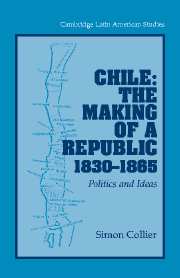Book contents
- Frontmatter
- Contents
- Acknowledgments
- Abbreviations Used in the Notes
- Introduction
- PART I THE NEW REPUBLIC, 1830–1865
- PART II FROM PORTALES TO MONTT, 1835–1851
- PART III MID-CENTURY ATTITUDES
- 5 Progress and Its Instruments
- 6 Political Argument
- 7 Model Republic
- 8 Looking Outward
- PART IV ORDER AND LIBERTY, 1851–1864
- Sources
- Index
6 - Political Argument
Published online by Cambridge University Press: 24 July 2009
- Frontmatter
- Contents
- Acknowledgments
- Abbreviations Used in the Notes
- Introduction
- PART I THE NEW REPUBLIC, 1830–1865
- PART II FROM PORTALES TO MONTT, 1835–1851
- PART III MID-CENTURY ATTITUDES
- 5 Progress and Its Instruments
- 6 Political Argument
- 7 Model Republic
- 8 Looking Outward
- PART IV ORDER AND LIBERTY, 1851–1864
- Sources
- Index
Summary
Now tell us all about the war,
And what they fought each other for.
The question Old Kaspar could not answer in Robert Southey's poem could well be applied to the early republic in Chile. What divided the political class, given its social and economic homogeneity, other than the eternal competition of “ins” and “outs” to be found in most political systems? That particular competition can frequently provoke fierce partisanship even in the absence of strong ideological differences. In essence, the divisions among Chileans stemmed mostly from conflicting views of how best to conduct the government of Chile, Conservatives believing above all in firm control, with repressive measures when needed (in their view), and their Liberal opponents arguing for a more relaxed approach, with proper respect for civil liberty. While a similar ideological tussle can be observed in many forms in the governing classes (and sometimes at a more popular level) all over nineteenth-century Latin America, the main issues in the political debate in Chile were rather clear. Unlike their counterparts in neighboring Argentina, for instance, Chilean politicians did not have to address the tangled themes of caudillo rule or the conflicting claims of sharply disparate regions. General Cruz and Pedro León Gallo, Chile's would-be caudillos (if it is right to call them that) in 1851 and 1859, did not aspire to dictatorship and firmly associated themselves with national visions of reform and liberty, very moderate in Cruz's case, more radical in Gallo's.
- Type
- Chapter
- Information
- Chile: The Making of a Republic, 1830–1865Politics and Ideas, pp. 122 - 144Publisher: Cambridge University PressPrint publication year: 2003

